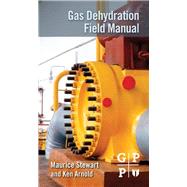- ISBN: 9781856179805 | 185617980X
- Cover: Paperback
- Copyright: 8/8/2011
Raw natural gas typically contains a substantial amount of water, which can degrade heating value and contribute to the formation of corrosion in piping and other equipment. Under certain conditions, natural gas hydrates can form, which can cause pipe blockages. Although dehydration historically has been a fairly inexpensive step in the upgrading of natural gas to pipeline quality, costs are increasing. Gas Dehydration Field Manual defines the various methods of gas dehydration and discusses the differences between adsorption and absorption.Designed for engineers, technologists, and operations personnel involved in the design and operation of gas processing facilities, the book starts with an explanation of the terms and theories used throughout the industry. This is followed by clear and rigorous exposition of dehydration processes such as Condensation process, Glycol Regeneration and Molecular Sieves.Exercises appear at the conclusion of each chapter with hints in addition to full solutions.Other topics include hydrate prevention, chemical injection systems, hydrate inhibitor methods. Chapters involving applications cover dehydrate considerations, operation principles, hydrate production correlations and production of operating temperatures and Pressures and glycol maintenance, care and trouble-shooting. An appendix provides the reader with additional exercises and solutions.Engineers and process designers will find this text a valuable guide to gas dehydration processes and equipment, both in terms of its application to efficient and cost effective operations. It will prove particularly useful to readers who want a "quick reference" guide to field operations and procedures as well as those readers who wish to increase their knowledge of best practices. Include hydrate prevention, chemical injection systems, hydrate inhibitor methodsCondensation process, Glycol Regeneration and Molecular SievesAn appendix provides the reader with additional exercises and solutions






